
MDR-NC40_CE7 [GB, FR, ES] 3-282-466-82 (1)
3 Turn on the power of the headphones.
The power indicator lights in red. The power
switch is located on the battery box. When
power is turned on, ambient noise is reduced,
and you can listen to music more clearly at a
lower volume.
Power indicator
Power switch
4 Start playing on the AV equipment.
To hear ambient sound for safety
When the power switch is set to on, noise canceling can be
deactivated while the MONITOR button is pressed so that
you can hear ambient sound.
MONITOR button
When using in an airplane
The supplied plug adaptor can be connected to the dual or
stereo mini jacks of in an airplane.
dual jacks stereo mini jacks
Do not use the headphones when use of electronic
equipment is prohibited or when use of personal
headphones for in-flight music services is prohibited.
If you have any questions or problems concerning the system
that are not covered in this manual, please consult the
nearest Sony dealer.
After use
Turn off the power of the headphones.
Notes
The noise canceling function is only effective for noise in the
low frequency band. Although noise is reduced, it is not
canceled completely.
Do not cover the microphone of the headphones with your
hands. The noise canceling function may not work properly.
Microphone
The noise canceling function may not work properly unless the
headphones are put on firmly.
You can use the headphones even without turning on the
power. In this case, the noise canceling function is not active,
and the headphones operate as passive headphones.
After you turn on the power of the headphones, you may hear
a slight hiss. This is the operating sound of the noise canceling
function, not a malfunction.
In a quiet place, or depending on certain noises, you may feel
that the noise canceling function is not effective, or that noise
is accentuated. In this case, turn off the power of the
headphones.
Using the clip
You can fasten the battery box by its clip on a shirt pocket.
Clip
Precautions
Do not put weight or pressure on the headphones as it may
cause the headphones to deform during long storage.
The earpads may deteriorate due to long-term storage or
use.
Be careful not to catch your finger as you fold the
headphones.
Clean the headphones with a soft dry cloth.
Do not leave the jack plug dirty otherwise the sound may
be distorted.
Be sure to bring the headphones to the Sony dealer when
requiring a change of earbuds or repair work.
Do not leave the headphones in a location subject to direct
sunlight, heat or moisture.
Do not subject the headphones to excessive shock.
Handle the driver units carefully.
If you fell drowsy or sick while using these headphones,
stop use immediately.
Mobile phones may cause noise. Keep the headphones
away from mobile phones.
If headphone sound is noisy, move the battery box away
from sources of interference, such as a radio, etc.
Notes on headphones
Preventing hearing damage
Avoid using headphones at high volume. Hearing experts
advise against continuous, loud and extended play. If you
experience a ringing in your ears, reduce the volume or
discontinue use.
Unfolding the
headphones
Storing the headphones in the carrying case
When storing the headphones in the supplied carrying case,
set the inner partition up, fold the headphones and store.
The plug adaptor and reserve battery can also be stored in
the pockets of the carrying case.
Listening to music
1 Connect the headphones to the AV equipment.
Plug adaptor (supplied)
When connecting to dual or
stereo mini jacks of in-flight
music services.
To headphone jacks
on airplane seats
When directly connecting to
the headphone jack (stereo
mini jack) of a “WALKMAN”,
etc.
When connecting to a remote
commander with a stereo
mini jack of a “WALKMAN”,
etc.
Remote commander
2 Wear the headphones marked in your right
ear and the one marked
in your left ear.
Features
Noise canceling headphones reduce unwanted ambient
noise and provide a quieter environment to enhance your
listening experience. Ambient sound is reduced by
synthesizing with a sound in opposite phase produced by
the noise canceling circuit.
Lightweight design for long lasting wearing comfort.
Super compact foldable design for carrying and storing.
Soft and comfortable fit from pressure-relieving urethane
ear cushion.
Built-in monitor function to hear surrounding sound.
Supplied plug adaptor for easy connectivity to stereo mini
or dual jacks for in-flight music services.
Operates as passive headphones when noise canceling
circuit is not activated.
Installing a battery
1 Push and slide the compartment lid on the rear
of the battery box fully, and open.
Before opening the compartment lid, check that
the claws of the lid are seen.
Claws
2 Insert one R03 (size AAA) battery, matching the
on the battery to the in the battery
compartment.
Insert the end
first.
3 Close the lid.
Battery life
Battery Approx. hours*
1
Sony alkaline battery LR03/
AM-4 (N)
40 hours*
2
Sony battery R03/UM-4 (NU) 20 hours*
2
*
1
1 kHz, 0.1 mW + 0.1 mW output
*
2
Time stated above may vary, depending on the temperature
or conditions of use.
When the battery is low
Power indicator dims, and the noise canceling function is
deactivated. Replace the battery with a new one in this case.
English
Noise Canceling Headphones
WARNING
To reduce the risk of fire or electric shock, do not
expose this apparatus to rain or moisture.
To reduce the risk of electrical shock, do not open
the cabinet. Refer servicing to qualified personnel
only.
You are cautioned that any changes or modifications not
expressly approved in this manual could void your authority
to operate this equipment.
The validity of the CE marking is restricted to only those
countries where it is legally enforced, mainly in the countries
EEA (European Economic Area).
Notice for customers: the following information is
only applicable to equipment sold in countries
applying EU directives
The manufacturer of this product is Sony Corporation, 1-7-1
Konan Minato-ku Tokyo, 108-0075 Japan. The Authorized
Representative for EMC and product safety is Sony
Deutschland GmbH, Hedelfinger Strasse 61, 70327 Stuttgart,
Germany. For any service or guarantee matters please refer
to the addresses given in separate service or guarantee
documents.
Disposal of Old Electrical & Electronic Equipment
(Applicable in the European Union and other
European countries with separate collection
systems)
This symbol on the product or on its packaging
indicates that this product shall not be treated as
household waste. Instead it shall be handed over
to the applicable collection point for the
recycling of electrical and electronic equipment.
By ensuring this product is disposed of correctly,
you will help prevent potential negative
consequences for the environment and human health, which
could otherwise be caused by inappropriate waste handling of
this product. The recycling of materials will help to conserve
natural resources. For more detailed information about recycling
of this product, please contact your local Civic Office, your
household waste disposal service or the shop where you
purchased the product.
Disposal of waste batteries (applicable in the
European Union and other European countries
with separate collection systems)
This symbol on the battery or on the packaging
indicates that the battery provided with this
product shall not be treated as household waste.
On certain batteries this symbol might be used
in combination with a chemical symbol. The
chemical symbols for mercury (Hg) or lead (Pb)
are added if the battery contains more than 0.0005% mercury or
0.004% lead.
By ensuring these batteries are disposed of correctly, you will
help prevent potentially negative consequences for the
environment and human health which could otherwise be
caused by inappropriate waste handling of the battery. The
recycling of the materials will help to conserve natural resources.
In case of products that for safety, performance or data integrity
reasons require a permanent connection with an incorporated
battery, this battery should be replaced by qualified service staff
only.
To ensure that the battery will be treated properly, hand over the
product at end-of-life to the applicable collection point for the
recycling of electrical and electronic equipment.
For all other batteries, please view the section on how to remove
the battery from the product safely. Hand the battery over to the
applicable collection point for the recycling of waste batteries.
For more detailed information about recycling of this product or
battery, please contact your local Civic Office, your household
waste disposal service or the shop where you purchased the
product.
Do not use headphones while driving and cycling, etc.
As headphones reduce outside sounds, they may cause a
traffic accident. Also, avoid listening with your headphones
in situations where hearing must not be impaired, for
example, a railroad crossing, a construction site, etc.
Troubleshooting
No sound
Check the connection of the headphones and the AV
equipment.
Check that the connected AV equipment is turned on.
Turn up the volume of the connected AV equipment.
Replace the battery.
Muffled sound
Turn down the volume of the connected AV equipment.
Replace the battery.
The sound of the connected source device, such as
radio and TV, cannot be heard, or headphone
sound is noisy.
Move the battery box away from the connected source
device.
Specifications
General
Type Closed, dynamic
Driver unit 30 mm, dome type (CCAW adopted)
Power handling capacity
50 mW
Impedance 68 Ω at 1 kHz (when the power is on)
30 Ω at 1 kHz (when the power is off)
Sensitivity 102 dB/mW (when the power is on)
100 dB/mW (when the power is off)
Frequency response
14 Hz - 22,000 Hz
Total Noise Suppression Ratio*
1
Approx. 10 dB*
2
Cord Approx. 1.5 m OFC litz cord (including
battery box)
Power source DC 1.5 V, 1 × R03 (size AAA) battery
Mass Approx. 110 g including battery box,
cord, and battery
Approx. 80 g not including battery box,
cord, and battery
Supplied accessories
Carrying case (1)
Plug adaptor for in-flight use*
3
(single/dual) (1)
Operating Instructions (1)
Sony R03 (size AAA) battery (1)
*
1
Under the Sony measurement standard.
*
2
Equivalent to approx. 90 % reduction of energy of sound
compared with not wearing headphones.
*
3
May not be compatible with some in-flight music services.
Design and specifications are subject to change without
notice.
“WALKMAN” and “WALKMAN” logo are registered
trademarks of Sony Corporation.
Français
Casque réducteur de bruits
AVERTISSEMENT
Afin de réduire les risques d’incendie ou de choc
électrique, n’exposez pas cet appareil à la pluie ni
à l’humidité.
Pour éviter tout risque d’électrocution, n’ouvrez
pas le coffret. Ne confiez les réparations qu’à un
technicien qualifié.
Toute modification ou tout changement que vous effectuez
et qui n’est pas expressément approuvé(e) dans ce manuel
peut annuler votre droit à utiliser cet appareil.
La validité du marquage CE est limitée uniquement aux pays
dans lesquels il fait force de loi, c’est-à-dire principalement
dans les pays de I’EEE (Espace Économique Européen).
Avis à l’intention des clients : les informations
suivantes s’appliquent uniquement aux appareils
vendus dans des pays qui appliquent les directives
de l’Union Européenne
Le fabricant de ce produit est Sony Corporation, 1-7-1
Konan Minato-ku Tokyo, 108-0075 Japon. Le représentant
autorisé pour les questions de compatibilité
électromagnétique (EMC) et la sécurité des produits est
Sony Deutschland GmbH, Hedelfinger Strasse 61, 70327
Stuttgart, Allemagne. Pour toute question relative au SAV ou
à la garantie, merci de bien vouloir vous référer aux
coordonnées contenues dans les documents relatifs au SAV
ou la garantie.
Traitement des appareils électriques et
électroniques en fin de vie (Applicable dans les
pays de l’Union Européenne et aux autres pays
européens disposant de systèmes de collecte
sélective)
Ce symbole, apposé sur le produit ou sur son
emballage, indique que ce produit ne doit pas
être traité avec les déchets ménagers. Il doit être
remis à un point de collecte approprié pour le
recyclage des équipements électriques et
électroniques. En s’assurant que ce produit est
bien mis au rebut de manière appropriée, vous
aiderez à prévenir les conséquences négatives potentielles pour
l’environnement et la santé humaine. Le recyclage des matériaux
aidera à préserver les ressources naturelles. Pour toute
information supplémentaire au sujet du recyclage de ce produit,
vous pouvez contacter votre municipalité, votre déchetterie ou le
magasin où vous avez acheté le produit.
Elimination des piles et accumulateurs usagés
(Applicable dans les pays de l’Union Européenne et
aux autres pays européens disposant de systèmes
de collecte sélective)
Ce symbole, apposé sur les piles et
accumulateurs ou sur les emballages, indique
que les piles et accumulateurs fournis avec ce
produit ne doivent pas être traités comme de
simples déchets ménagers.
Sur certains types de piles, ce symbole apparaît
parfois combiné avec un symbole chimique. Les symboles pour
le mercure (Hg) ou le plomb (Pb) sont rajoutés lorsque ces piles
contiennent plus de 0,0005% de mercure ou 0,004% de plomb.
En vous assurant que ces piles et accumulateurs sont mis au
rebut de façon appropriée, vous participez activement à la
prévention des conséquences négatives que leur mauvais
traitement pourrait provoquer sur l’environnement et sur la santé
humaine. Le recyclage des matériaux contribue par ailleurs à la
préservation des ressources naturelles.
Pour les produits qui pour des raisons de sécurité, de
performance ou d’intégrité de données nécessitent une
connexion permanente à une pile ou à un accumulateur, il
conviendra de vous rapprocher d’un service technique qualifié
pour effectuer son remplacement.
En rapportant votre appareil électrique en fin de vie à un point
de collecte approprié vous vous assurez que la pile ou
l’accumulateur incorporée sera traitée correctement.
Pour tous les autres cas de figure et afin d’enlever les piles ou
accumulateurs en toute sécurité de votre appareil, reportez-vous
au manuel d’utilisation. Rapportez les piles ou accumulateurs
usagés au point de collecte approprié pour le recyclage.
Pour toute information complémentaire au sujet du recyclage de
ce produit ou des piles et accumulateurs, vous pouvez contacter
votre municipalité, votre déchetterie locale ou le point de vente
où vous avez acheté ce produit.
Caractéristiques
Casque anti-bruit réduisant le bruit ambiant et permettant
d’écouter de la musique dans un environnement plus calme
avec un confort d’écoute accru. Les sons environnants sont
réduits en les synthétisant avec un son en opposition de
phase produit par le circuit anti-bruit.
Confort d’écoute prolongée accru grâce à son faible poids.
Modèle pliable extrêmement compact pratique pour le
rangement et le stockage.
Coussinet pour oreillette en uréthane souple conçu pour
éviter toute pression excessive et garantir une écoute
confortable.
Fonction de contrôle intégrée permettant d’entendre les
bruits environnants.
Adaptateur de fiches fourni pour faciliter le raccordement
à des mini-prises stéréo ou des prises doubles pour les
services de musique en vol.
Casque fonctionnant comme un casque d’écoute passif
lorsque le circuit anti-bruit est désactivé.
Mise en place de la pile
1 Appuyez à fond sur le couvercle situé à l’arrière
du boîtier de la pile, puis faites-le glisser
complètement pour l’ouvrir.
Avant d’ouvrir le couvercle du boîtier, vérifiez
que les griffes du couvercle sont bien visibles.
Griffes
2 Insérez une pile R03 (AAA) en faisant
correspondre les polarités
de la pile avec les
repères
du logement des piles.
Insérez le pôle
en premier.
3 Refermez le couvercle.
Autonomie de la pile
Pile Durée approximative*
1
Pile alcaline Sony LR03/
AM-4 (N)
40 heures*
2
Pile Sony R03/UM-4 (NU) 20 heures*
2
*
1
1 kHz, 0,1 mW + 0,1 mW en sortie
*
2
La durée mentionnée ci-dessus peut varier selon la
température ou les conditions d’utilisation.
Le niveau de la pile est faible
L’indicateur d’alimentation s’allume faiblement et la fonction
anti-bruit est désactivée. Dans ce cas, remplacez la pile par
une neuve.
Dépliage du casque
Rangement du casque dans l’étui de transport
Lors du rangement du casque dans l’étui de transport fourni,
réglez la cloison, pliez le casque et rangez-le. L’adaptateur de
fiche et la pile de rechange peuvent également être rangés
dans les poches de l’étui de transport.
Ecoute de musique
1 Raccordez le casque à un appareil audio et vidéo.
Adaptateur de fiche
(fourni)
Raccordement aux mini-prises
stéréo ou doubles des services
de musique en vol.
Vers la prise de casque
des sièges d’avion
Lors du raccordement direct à
la prise de casque (mini-prise
stéréo) d’un « Walkman », etc.
Lors du raccordement à une
télécommande via la mini-
prise stéréo d’un
« Walkman », etc.
Télécommande
2 Placez l’écouteur portant le repère dans
l’oreille droite et l’écouteur portant le repère
dans l’oreille gauche.
3 Mettez le casque d’écoute sous tension.
L’indicateur d’alimentation s’allume en rouge.
L’interrupteur d’alimentation se trouve sous le
boîtier de la pile. Lorsque le casque est sous
tension, les sons environnants sont réduits et
vous pouvez écouter de la musique plus
clairement à un volume plus faible.
Indicateur
d’alimentation
Interrupteur
4 Démarrez la lecture sur l’appareil audio et vidéo.
Sons environnants audibles pour votre sécurité
Lorsque l’interrupteur d’alimentation est réglé sur la position
marche, la fonction anti-bruit peut être désactivée en
appuyant sur la touche MONITOR, afin de pouvoir entendre
les sons environnants.
Touche MONITOR
Utilisation à bord d’un avion
L’adaptateur de fiche fourni peut être raccordé aux mini-
prises stéréo ou doubles des services de musique en vol.
Prises doubles Mini-prises stéréo
N’utilisez pas le casque d’écoute si l’utilisation d’appareils
électroniques est interdite ou si l’utilisation de casques
d’écoute personnels pour les appareils audio à bord de
certains avions est interdite.
Si vous avez des questions ou des problèmes qui ne sont pas
abordés dans ce manuel, consultez votre revendeur Sony.
Après utilisation
Mettez les écouteurs hors tension.
Remarques
La fonction anti-bruit est efficace uniquement pour les bruits à
basses fréquences. Bien que les bruits soient réduits, ils ne sont
pas complètement inaudibles.
Ne masquez pas le microphone du casque d’écoute avec vos
mains. Sinon, il est possible que la fonction anti-bruit ne
fonctionne pas correctement.
Microphone
Installez correctement le casque d’écoute. Sinon, il est possible
que la fonction anti-bruit ne fonctionne pas correctement.
Vous pouvez utiliser le casque sans le mettre sous tension. La
fonction anti-bruit est alors inactive et le casque passif.
Après avoir mis le casque sous tension, un léger sifflement peut
se faire entendre. Ce sifflement est provoqué par la fonction
anti-bruit et n’a rien d’anormal.
Dans un endroit calme ou selon les bruits émis, vous pouvez
avoir l’impression que la fonction anti-bruit n’est pas efficace,
voire même que ces bruits sont amplifiés. Dans ce cas, mettez
le casque hors tension.
Utilisation de l’agrafe
L’agrafe vous permet de fixer le boîtier de la pile à une poche
de chemise.
Agrafe
Voir au verso
3-282-466-82(1)
Noise Canceling
Headphones
MDR-NC40
©2009 Sony Corporation Printed in Malaysia
Operating Instructions GB
Mode d’emploi FR
Manual de instrucciones ES

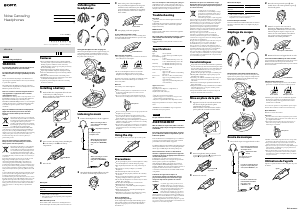


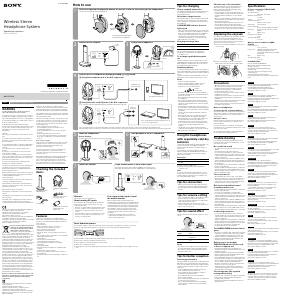
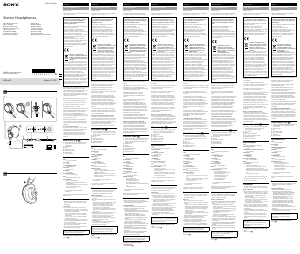

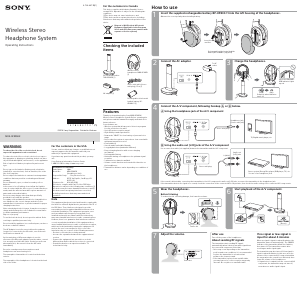
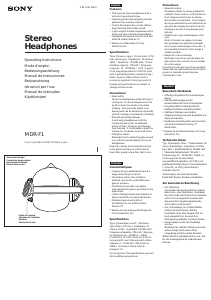
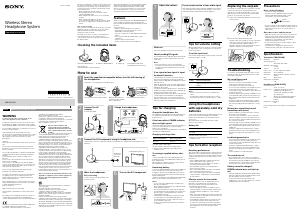
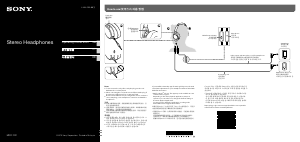
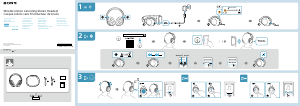
Join the conversation about this product
Here you can share what you think about the Sony MDR-NC40 Headphone. If you have a question, first carefully read the manual. Requesting a manual can be done by using our contact form.